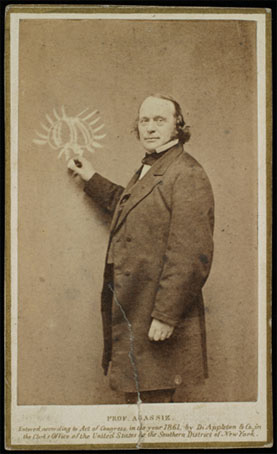Louis Agassiz (1807-1873)

|
| Louis Agassiz, [1860s]. Archive ref: GSL/POR/51/01-02. |
Jean Louis Rudolphe Agassiz (1807-1873), born in Môtier, Switzerland, is probably better known today for his studies of glaciation. However, his first great passion was the study of fish (ichthyology) which had developed whilst he was at university, ostensibly studying for a medical degree. Even before graduating in 1829 at the age of 22, he had authored or co-authored two publications on the subject and it was whilst researching for his next work, this time on the freshwater fish of Europe, that he became fascinated by their fossilised forms.
When Louis Agassiz arrived in Britain during the autumn of 1834, he had already received the Wollaston Fund from the Geological Society to support him in his researches for his five volume work 'Recherches sur les Poissons Fossiles' (1833-1843), which he had been working on for two years. The Geological Society, eager to help with such an important palaeontological and geological work, issued a call to its Fellows to send examples of fossil fish to aid Agassiz and a room was set aside for the specimens to be copied by his main artist, the Austrian Joseph Dinkel [1806-1891].
For the next decade, Agassiz continued to visit the palaeontological collections of Britain and Europe seeking out new specimens for his work. The cost of the research involved in such a major work, combined with the expensive colour printing techniques saw Agassiz accepting help from various friends and scientific figures of the time. Despite this, Agassiz still had to sell his own natural history collection to the local authorities at Neuchâtel to meet the high production costs, and with nothing left apart from the original artwork, which was of no further use once converted to lithographic images, these were next marked to be sold. The majority of the drawings were purchased for £500 by Lord Francis Leveson-Gower in 1843 which were then given to the Geological Society.
By the time the follow up volume 'Monographie des Poissons Fossiles du Vieux Grès Rouge' (1844-1845) had been issued Agassiz's interest had switched to other subjects such as his studies on glaciers and the ice age. In 1846 he left Europe for the United States where he widely lectured at the Lowell Institute, Harvard and Cornell Universities.
Agassiz's scientific reputation has been damaged due to the racist views which he developed after his emigration to the United States. There he became a leading spokesman for the theory of 'polygeny' which is the concept that different races are effectively a different and lesser taxonomical species than the white race. Polygeny was one of a number of prejudicial pseudosciences that developed across Europe and the United States in the 19th century to give academic credence and justification for the inherent prejudices and mistreatments of the age.
<<Back to exhibition